Theoretical Approach to Predicting the Diffusion Radius of Fracture Grouting in Soil–Rock Mixtures
Abstract
:1. Introduction
- (1)
- Derivation of the Bingham fluid flow equation.
- (2)
- Establishing the diffusion formula of soil–rock mixture fracture grouting under Bingham fluid.
- (3)
- Conducting field grouting tests and indoor model tests under different working conditions.
- (4)
- Adaptation verification of the fracture grouting diffusion equation using grout diffusion radius data from field grouting tests and indoor model tests.
2. Calculation Theory for Fracture Diffusion of Bingham Fluid
2.1. Bingham Fluid Flow Equation
2.2. Bingham Fluid Fracture Diffusion Equation
3. Validation Tests of the Calculation Theory of Grout Diffusion in Soil–Rock Mixtures
3.1. Indoor Grouting Tests
3.1.1. Test Conditions
3.1.2. Test Device and Process
- (1)
- Test Device
- (2)
- Test processThe indoor test process is as follows:
- (a)
- Control particle grading: soil–rock mixture sampling was carried out from the construction site to determine the particle gradation (shown in Figure 4), and the soil–rock mixture samples were configured in the room.
- (b)
- Control water content: The dried soil–rock mixture sample was mixed evenly one day in advance and laid flat in the aluminum box, sprinkled evenly with water, and mixed thoroughly to ensure that the water content was equal to the natural water content of the original soil–rock mixture, covered with plastic film for 24 h, and then taken, as shown in Figure 5.
- (c)
- Soil–rock mixture specimen: In the grouting bucket against the wall set of plastic bags, the soil–rock mixture was added to the mold in 4 layers. Each layer was 150 mm thick, and the height was controlled in layers. The soil–rock mixture layer was compacted with a wooden compaction hammer according to the principle of light hammering and multi-striking to ensure that the dry density of the configured specimen was equal to the dry density of the original soil–stone mixture, as shown in Figure 6. To prevent the appearance of a preset weak surface between layers, surface chiseling treatment was carried out after each layer was compacted before adding soil samples.
- (d)
- Buried pipe: After the soil–rock mixture sample was added to 3 layers, the grouting pipe was buried, and the position of the grouting pipe mouth was fixed. To prevent the soil–rock mixture in the mouth of the pipe from blocking the pipe, a layer of gravel was placed under the pipe mouth so that it was wrapped by gravel, and then the position of the grouting pipe was fixed, as shown in Figure 7. Then, the fourth layer of the soil–rock mixture was buried, compacted, and sealed with a cover.
- (e)
- Safety check: After connecting the device, we opened the inlet valve, closed the outlet valve, opened the main valve of the nitrogen tank, and adjusted the output pressure to 0.2 MPa. Then, we closed the main valve after the air pressure in the slurry storage barrel was stable. If the pressure value of the pressure gauge on the slurry storage barrel remained unchanged for 5 min, we considered the sealing gaskets, valves, and pipes as gas-tight at these critical connection locations and the device as safe.
- (f)
- Slurry making: First, we poured a specific mass of cement and water into the mixing barrel according to the water–cement ratio. Second, we used a handheld electric drill equipped with a cross-stirring bar to stir at a speed of (500 rpm) in the mixing barrel at a constant speed for 5 min, and finally, poured the cement slurry quickly through the funnel into the slurry storage barrel, installed a pressure gauge, and set the scale to zero (the slurry storage barrel was located on the scale).
- (g)
- Pressurized grouting: We set the grouting pressure to the test pressure, opened the slurry outlet valve, and started grouting.
- (h)
- End of grouting: The end of grouting was marked by no change in the amount of grouting for 5 min. We closed the valve, stopped timing, pulled out the grouting pipe, inserted it into the waste bucket, opened the valve, and waited until all the slurry flowed out and all the gas was discharged.
3.1.3. Basic Physical and Mechanical Parameters of the Soil
3.2. Field Grouting Tests
3.2.1. Test Conditions
3.2.2. Test Device
3.2.3. Basic Physical and Mechanical Parameters of the Soil
4. Results and Discussion
4.1. Mechanism of Slurry Diffusion of Indoor Grouting Tests
4.2. Mechanism of Slurry Diffusion of Field Grouting Tests
4.3. Diffusion Radius Results
4.4. The Fracture Diffusion Formula of Bingham Fluid in Clay
4.5. The Fracture Diffusion Formula of Bingham Fluid in the Soil–Rock Mixtures
5. Conclusions
- (1)
- Based on the rheological characteristics of Bingham fluid and the assumption of a spherical diffusion model of grouting, the flow equation of the Bingham fluid was obtained, and the formula for calculating the fracture diffusion radius of Bingham fluid was derived. The formula considers the influence of the main parameters, such as stone content, void ratio, water–cement ratio, and grouting pressure.
- (2)
- The slurry’s diffusion mode in the soil–rock mixtures (stone content 30%) can be summarized as the main-fracture-sub-permeation mode. In the middle period before diffusion, the structure of the backfill of the soil–stone mixtures is loose before reinforcement, the initial kinetic energy of slurry diffusion is the largest, and the resistance to overcome is small. At this time, the midpoint of the slurry outlet of the cuff pipe is the midpoint, the main slurry veins and secondary slurry veins are formed rapidly along the soft surface, and fracture diffusion is dominant at this stage. At the later stage of diffusion, the void ratio in the reinforced area decreases, and the resistance of the slurry to continue expanding along the main slurry vein or secondary slurry vein channels increases so that the pores can only be filled along the vicinity of the main slurry vein or the boundary area, mainly by permeation diffusion. Finally, the slurry–rock cement skeleton is formed, and the skeleton is wrapped and packed with the soil in the grouting to strengthen the concretion.
- (3)
- The formula for fracture diffusion of a Bingham fluid is derived. The formula is brought into the test conditions under the corresponding working conditions for calculation. After comparing the calculated values with the test values for verification (the error of indoor model test results is less than 3%, and the error of field test results is less than 5%), it is confirmed that the formula applies to various working conditions of fracture grouting of the soil–rock mixtures and has a good prediction effect on the value of the fracture diffusion radius.
Author Contributions
Funding
Institutional Review Board Statement
Informed Consent Statement
Data Availability Statement
Conflicts of Interest
References
- Xu, W.J.; Hu, R.L. Conception, classification and significations of Soil-rock mixture. Hydrogeol. Eng. Geol. 2009, 36, 50–56, 70. (In Chinese) [Google Scholar]
- The Research Group of the Grouting Theories and Case Histories. The Grouting Theories and Case Histories; Science Press: Beijing, China, 2001; pp. 115–118. (In Chinese) [Google Scholar]
- Sun, F.; Chen, T.L.; Zhang, D.L.; Zhang, Z.J.; Li, P.F. Study on Fracture Grouting Mechanism in Subsea Tunnel Based on Bingham Fluids. J. Beijing Jiaotong Univ. 2009, 33, 1–6. (In Chinese) [Google Scholar]
- Zhong, Z.L.; Tu, Y.L.; He, X.Y.; Feng, J.H.; Wang, Z.L. Research Progress on Physical Index and Strength Characteristics of Bimsoils. Chin. J. Undergr. Space Eng. 2016, 12, 1135–1144. (In Chinese) [Google Scholar]
- Zhang, J.X. Mechanism of Fracture Grouting of Power-law Fluid. J. Yangtze River. Sci. Res. Inst. 2016, 33, 113–118. (In Chinese) [Google Scholar]
- Zhang, Z.L.; Shao, Z.S.; Fang, X.B.; Lian, X.J. Research on the Fracture Grouting Mechanism and PFC Numerical Simulation in Loess. Adv. Mater Sci. Eng. 2018, 2018, 4784762. [Google Scholar] [CrossRef] [Green Version]
- Chen, T.L.; Zhang, L.Y.; Zhang, D.L. An FEM/VOF hybrid formulation for fracture grouting modeling. Comput. Geotech. 2014, 2014, 14–27. [Google Scholar] [CrossRef]
- Park, D.; Oh, J. Permeation grouting for remediation of dam cores. Eng. Geol. 2018, 233, 63–75. [Google Scholar] [CrossRef]
- Funehag, J.; Fransson, A. Sealing narrow fractures with a Newtonian fluid: Model prediction for grouting verified by field study. Tunn. Undergr. Space Technol. 2006, 21, 492–498. [Google Scholar] [CrossRef]
- Sarris, E.; Papanastasiou, P. Numerical modeling of fluid-driven fractures in cohesive poroelastoplastic continuum. Int. J. Numer. Anal. Methods Geomech. 2013, 37, 1822–1846. [Google Scholar] [CrossRef]
- Bezuijen, A.; te Grotenhuis, R.; van Tol, A.F.; Bosch, J.W.; Haasnoot, J.K. Analytical Model for Fracture Grouting in Sand. J. Geotech. Geoenviron. 2011, 137, 611–620. [Google Scholar] [CrossRef]
- Yun, J.W.; Park, J.J.; Kwon, Y.S.; Kim, B.K.; Lee, I.M. Cement-based fracture grouting phenomenon of weathered granite soil. KSCE J. Civ. Eng. 2017, 21, 232–242. [Google Scholar] [CrossRef]
- Fattah, M.Y.; Al-Saidi, A.A.; Jaber, M.M. Improvement of bearing capacity of footing on soft clay grouted with lime-silica fume mix. Geomech. Eng. 2015, 8, 113–132. [Google Scholar] [CrossRef]
- Kim, D.; Park, K. Evaluation of the grouting in the sandy ground using bio injection material. Geomech. Eng. 2017, 12, 739–752. [Google Scholar] [CrossRef]
- Neupane, D.; Yasuhara, H.; Kinoshita, N.; Putra, H. Distribution of grout material within 1-m sand column in insitu calcite precipitation technique. Soils Found. 2015, 55, 1512–1518. [Google Scholar] [CrossRef] [Green Version]
- Saiyouri, N.; Jason, L.; Chupin, O.; Hicher, P.Y. Modeling and acoustic monitoring of grout propagation in sands. Ground. Improv. 2008, 161, 143–152. [Google Scholar] [CrossRef] [Green Version]
- Cheng, P.D.; Li, L.; Tang, J.; Wang, D.Z. Application of Time-Varying Viscous Grout in Gravel foundation Anti-Seepage Treatment. J. Hydrodyn. 2011, 23, 391–397. [Google Scholar] [CrossRef]
- Jiang, N.; Zhao, J.H.; Sun, X.Z.; Bai, L.Y.; Wang, C.X. Use of fly ash slurry in backfill grouting in coal mines. Heliyon 2017, 3, e00470. [Google Scholar] [CrossRef]
- Funehag, J.; Thörn, J. Radial permeation of cementitious grout-Laboratory verification of grout spread in a fracture model. Tunn. Undergr. Space Technol. 2018, 72, 228–232. [Google Scholar] [CrossRef]
- Mohajerani, S.; Baghbanan, A.; Bagherpour, R.; Hashemolhosseini, H. Grout permeation in fractured rock mass using a new developed explicit algorithm. Int. J. Rock Mech. Min. 2015, 80, 412–417. [Google Scholar] [CrossRef]
- Mohajerani, S.; Baghbanan, A.; Wang, G.; Forouhandeh, S.F. An efficient algorithm for simulating grout propagation in 2D discrete fracture networks. Int. J. Rock Mech. Min. 2017, 98, 67–77. [Google Scholar] [CrossRef]
- Zou, L.C.; Håkansson, U.; Cvetkovic, V. Two-phase cement grout propagation in homogeneous water-saturated rock fractures. Int. J. Rock Mech. Min. 2018, 106, 243–249. [Google Scholar] [CrossRef]
- Yang, Z.Q.; Hou, K.P.; Guo, T.T. Research on Time-Varying Behavior of Cement Grouts of Different Water-Cement Ratios. Appl. Mech. Mater. 2011, 71–78, 4398–4401. [Google Scholar] [CrossRef]
- Zheng, G.; Zhang, X.S.; Diao, Y.; Lei, H.Y. Experimental study on the performance of compensation grouting in structured soil. Geomech. Eng. 2016, 10, 335–355. [Google Scholar] [CrossRef]
- Zhou, Z.; Cai, X.; Du, X.M.; Wang, S.Y.; Ma, D.; Zang, H.Z. Strength and filtration stability of cement grouts in porous media. Tunn. Undergr. Space Technol. 2019, 89, 1–9. [Google Scholar] [CrossRef]
- Azadi, M.R.; Taghichian, A.; Taheri, A. Optimization of cement-based grouts using chemical additives. J. Rock Mech. Geotech. Eng. 2017, 9, 623–637. [Google Scholar] [CrossRef]
- Kongar-Syuryun, C.; Aleksakhin, A.; Khayrutdinov, A.; Tyulyaeva, Y. Research of rheological characteristics of the mixture as a way to create a new backfill material with specified characteristics. Mater. Today Proc. 2021, 38, 2052–2054. [Google Scholar] [CrossRef]
- Ermolovich, E.A.; Ivannikov, A.L.; Khayrutdinov, M.M.; Kongar-Syuryun, C.B.; Tyulyaeva, Y.S. Creation of a Nanomodified Backfill Based on the Waste from Enrichment of Water-Soluble Ores. Materials 2022, 15, 3689. [Google Scholar] [CrossRef]
- Adigamov, A.; Rybak, J.; Golovin, K.; Kopylov, A. Mechanization of stowing mix transportation, increasing its efficiency and quality of the created mass. Transp. Res. Procedia 2021, 57, 9–16. [Google Scholar] [CrossRef]
- Khayrutdinov, A.; Kongar-Syuryun, C.; Kowalik, T.; Faradzhov, V. Improvement of the backfilling characteristics by activation of halite enrichment waste for non-waste geotechnology. IOP Conf. Ser. Mater. Sci. Eng. 2020, 867, 012018. [Google Scholar] [CrossRef]
- Liao, Z.; Feng, T. Mechanism and Application of Layered Grouting Reinforcement for Fractured Coal and Rock Roadway. Appl. Sci. 2023, 13, 724. [Google Scholar] [CrossRef]
- Zhu, Y.; Wang, X.; Deng, S.; Chen, W.; Shi, Z.; Xue, L.; Lv, M. Grouting Process Simulation Based on 3D Fracture Network Considering Fluid-Structure Interaction. Appl. Sci. 2019, 9, 667. [Google Scholar] [CrossRef] [Green Version]
- Ding, W.; Duan, C.; Zhang, Q. Experimental and Numerical Study on a Grouting Diffusion Model of a Single Rough Fracture in Rock Mass. Appl. Sci. 2020, 10, 7041. [Google Scholar] [CrossRef]
- Sun, S.R.; Xu, P.L.; Wu, J.M.; Wei, J.H.; Fu, W.G.; Liu, J.; Kanungo, D.P. Strength parameter identification and application of soil-rock mixtures for steep-walled talus slopes in southwestern China. Bull. Eng. Geol. Environ. 2014, 73, 123–140. [Google Scholar] [CrossRef]
- Wang, Y.; Li, X. Experimental study on cracking damage characteristics of a soil and rock mixture by UPV testing. Bull. Eng. Geol. Environ. 2015, 74, 775–788. [Google Scholar] [CrossRef]
- Zhou, Z.; Yang, H.; Xing, K.; Gao, W.Y. Prediction models of the shear modulus of normal or frozen Soil-rock mixtures. Geomech. Eng. 2018, 15, 783–791. [Google Scholar] [CrossRef]
- Meng, Q.X.; Wang, H.L.; Xu, W.Y.; Cai, M. A numerical homogenization study of the elastic property of a soil-rock mixture using random mesostructure generation. Comput. Geotech. 2018, 98, 48–57. [Google Scholar] [CrossRef]
- Shan, P.F.; Lai, X.P. Mesoscopic structure PFC∼2D model of soil rock mixture based on digital image. J. Vis. Commun. Image Represent. 2019, 58, 407–415. [Google Scholar] [CrossRef]
- Zhang, L.L.; Fredlund, D.G.; Fredlund, M.D.; Wilson, G.W. Modeling the unsaturated soil zone in slope stability analysis. Can. Geotech. J. 2014, 51, 1384–1398. [Google Scholar] [CrossRef]
- Chen, L.X.; Ghorbani, J.; Zhang, C.S.; Dutta, T.T.; Kodikara, J. A novel unified model for volumetric hardening and water retention in unsaturated soils. Comput. Geotech. 2021, 140, 104446. [Google Scholar] [CrossRef]
- Lu, N.; Kaya, M. Power Law for Elastic Moduli of Unsaturated Soil. J. Geotech. Eng. 2014, 140, 46–56. [Google Scholar] [CrossRef]
- Ruan, W.J. Research on diffusion of grouting and basic properties grouts. Chin. J. Geotech. Eng. 2005, 69–73. (In Chinese) [Google Scholar]
- Zou, J.F.; Li, L.; Yang, X.L.; Hu, Z.N. Mechanism analysis of fracture grouting in soil. Rock Soil Mech. 2006, 27, 625–628, 642. (In Chinese) [Google Scholar]
- Wu, X.X. Building Foundation Engineering; South China University of Technology Press: Guangzhou, China, 2006; pp. 63–66. (In Chinese) [Google Scholar]
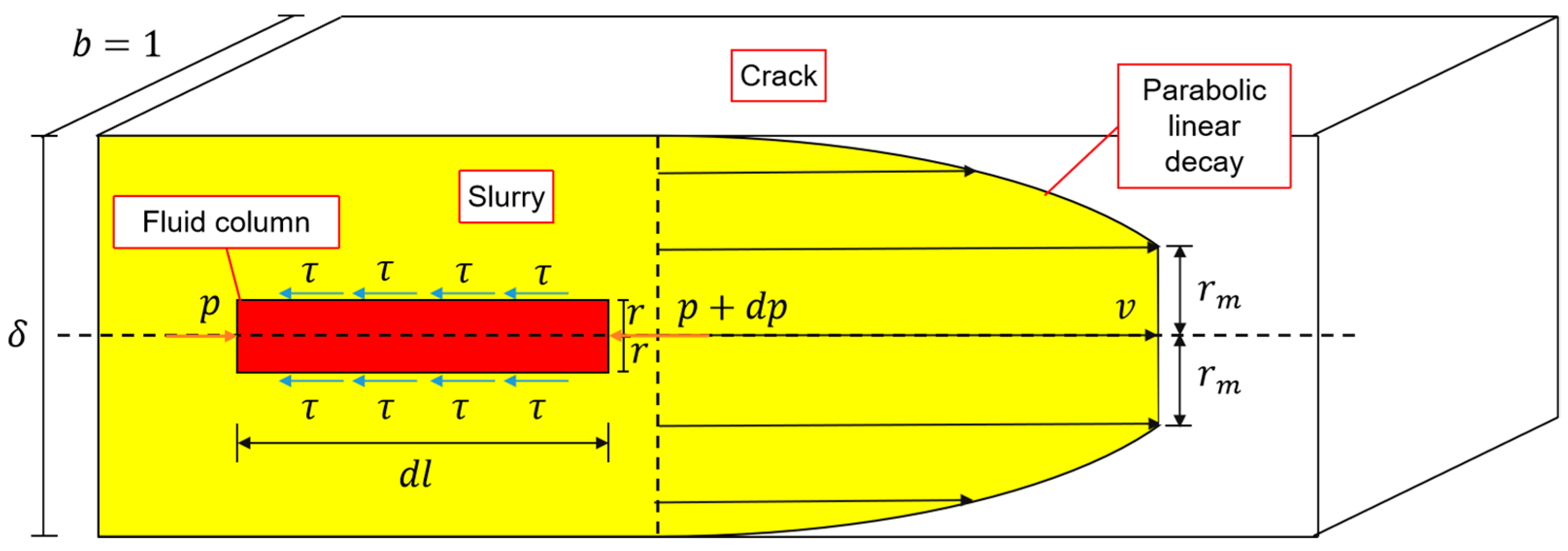

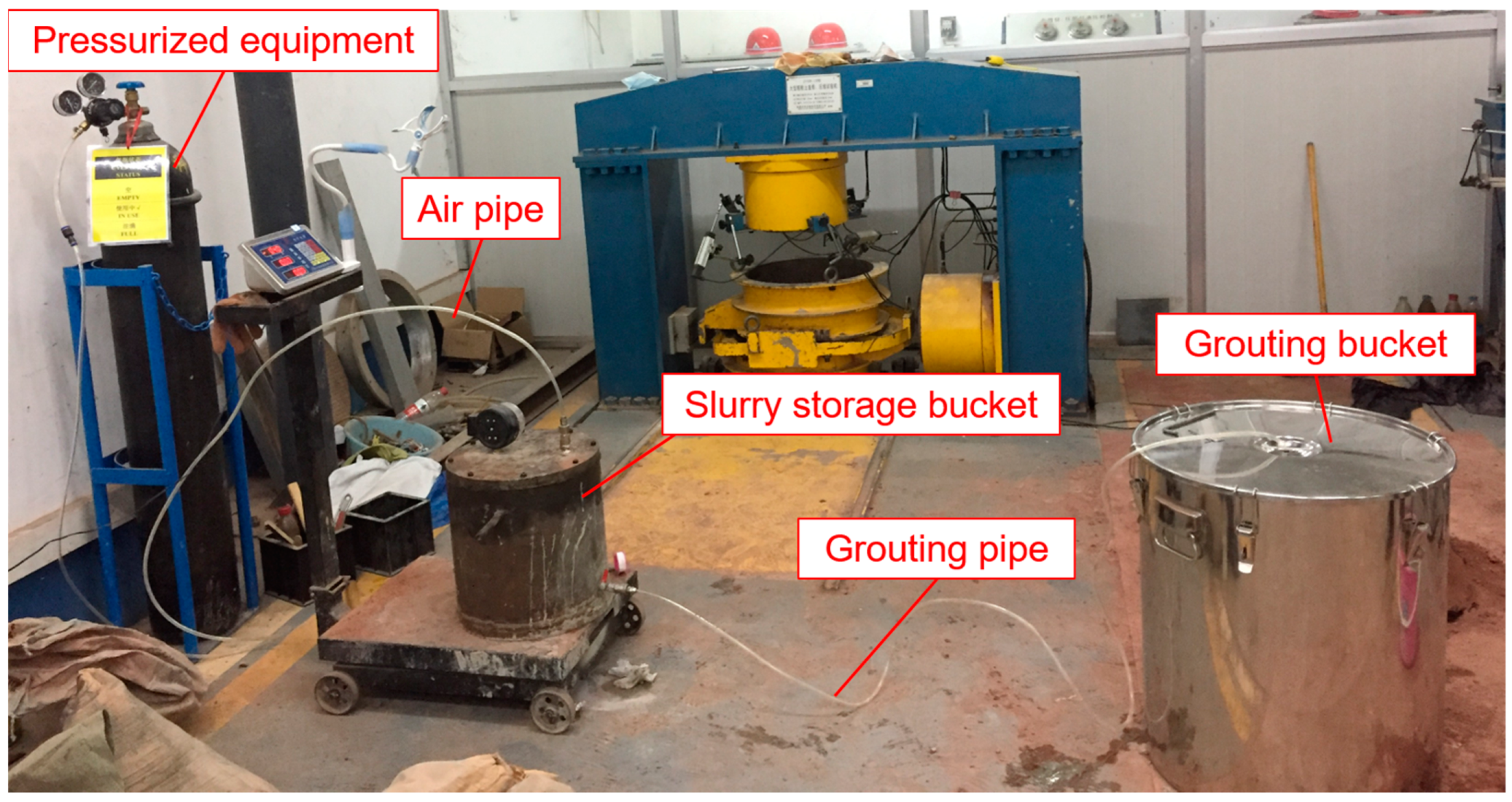


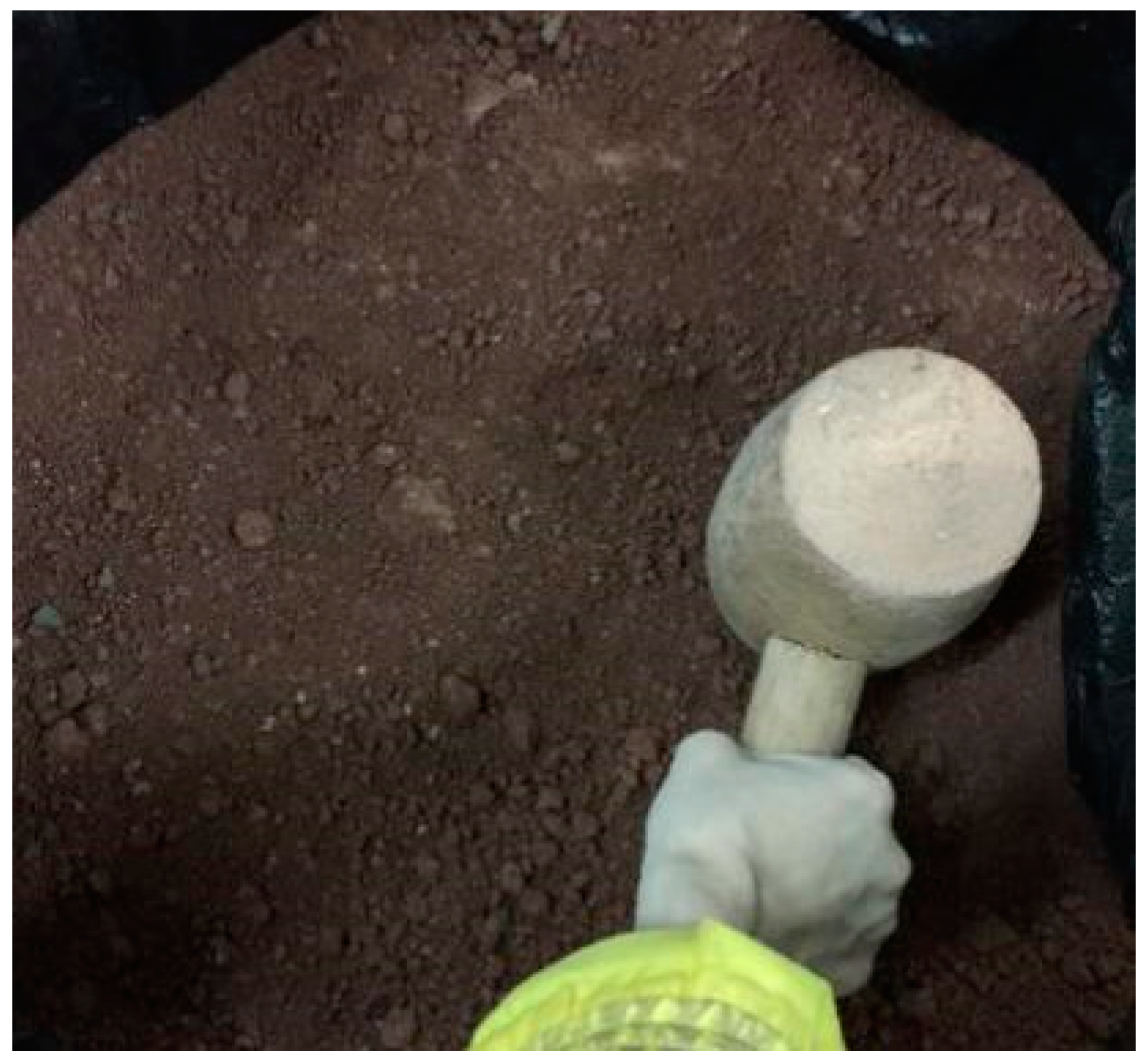
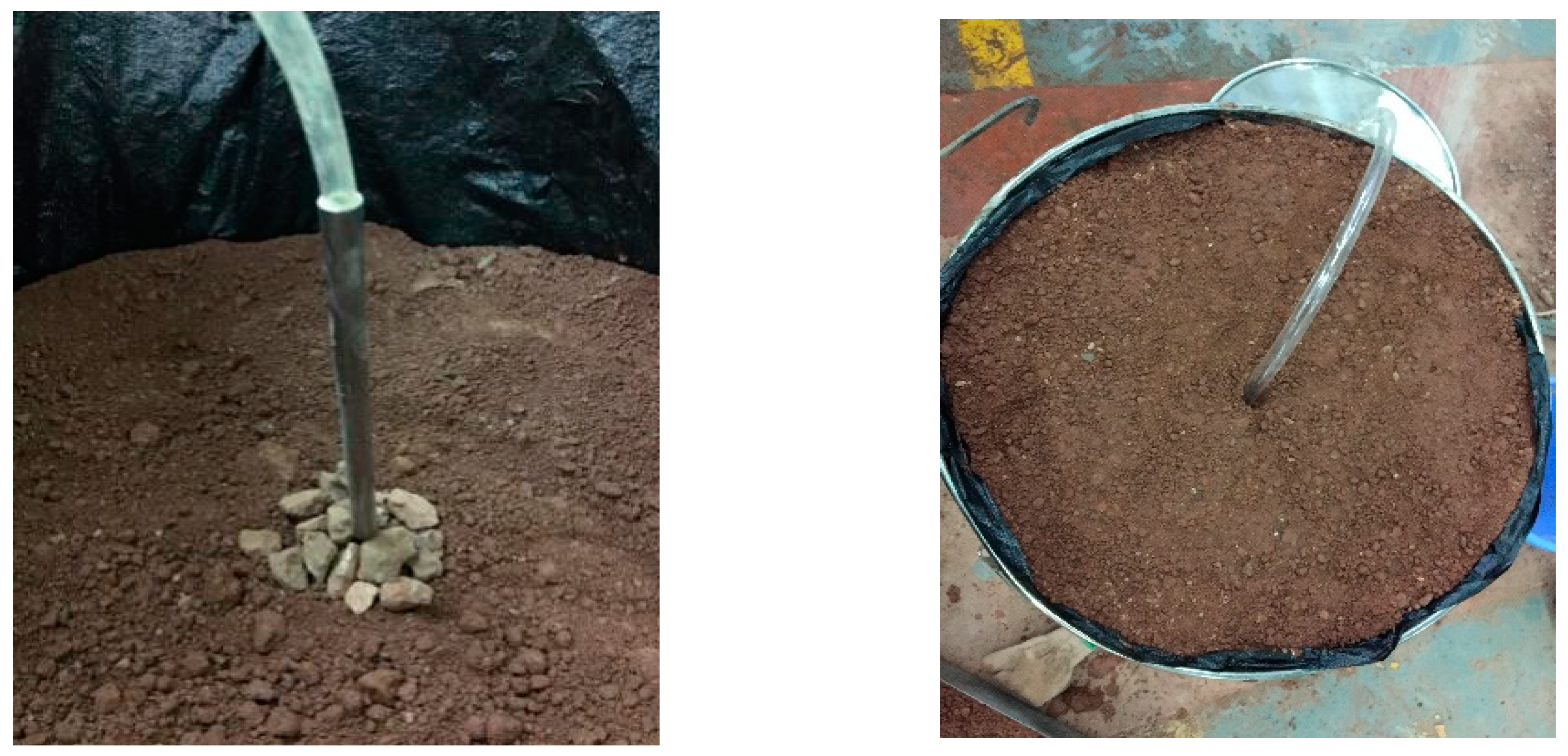
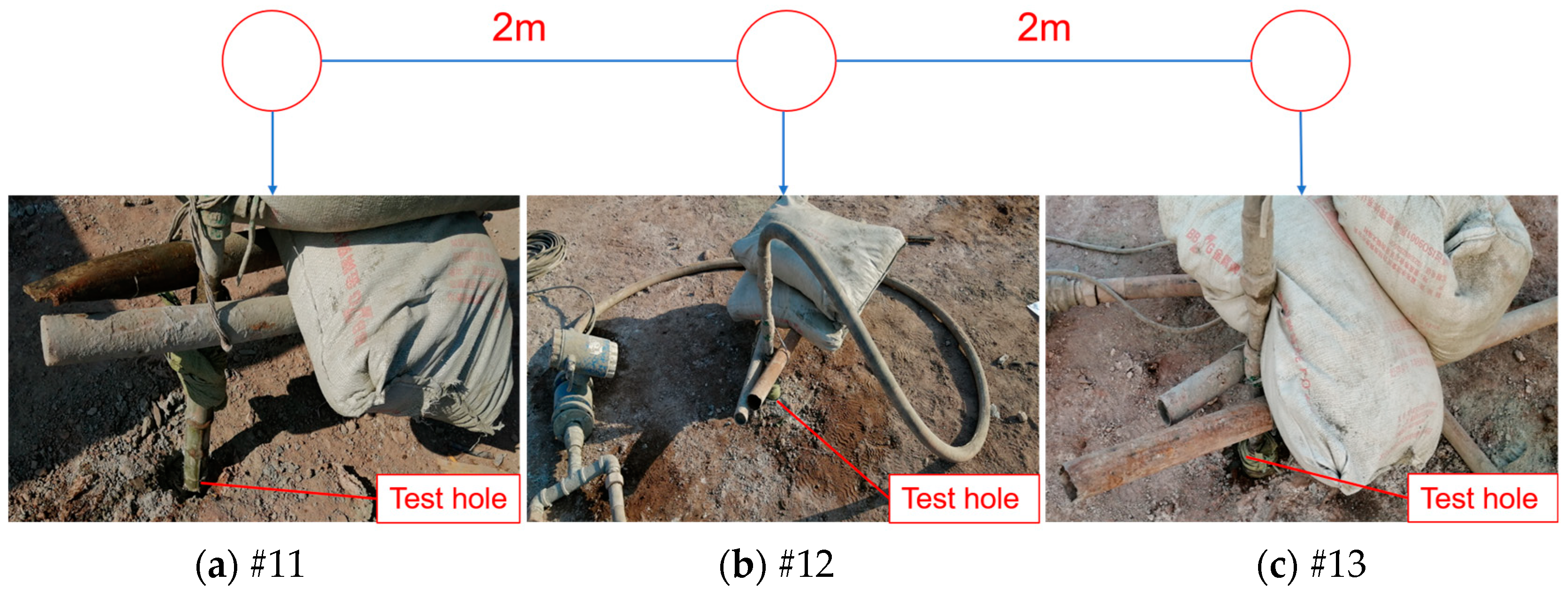

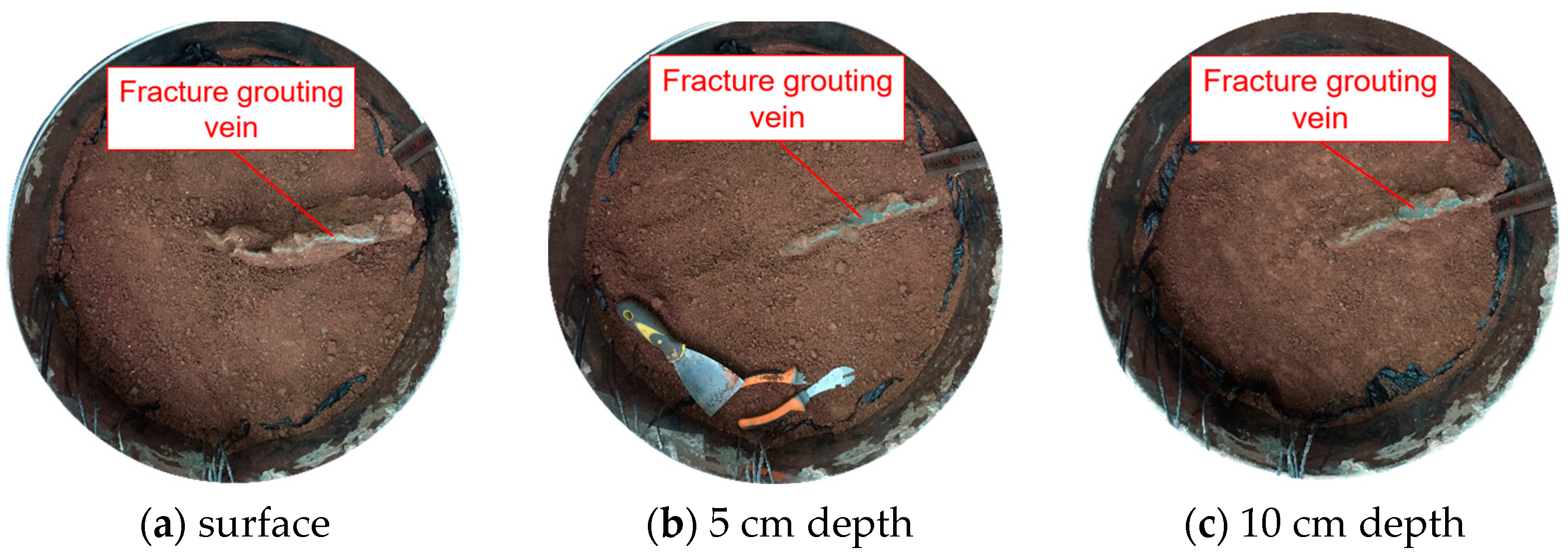
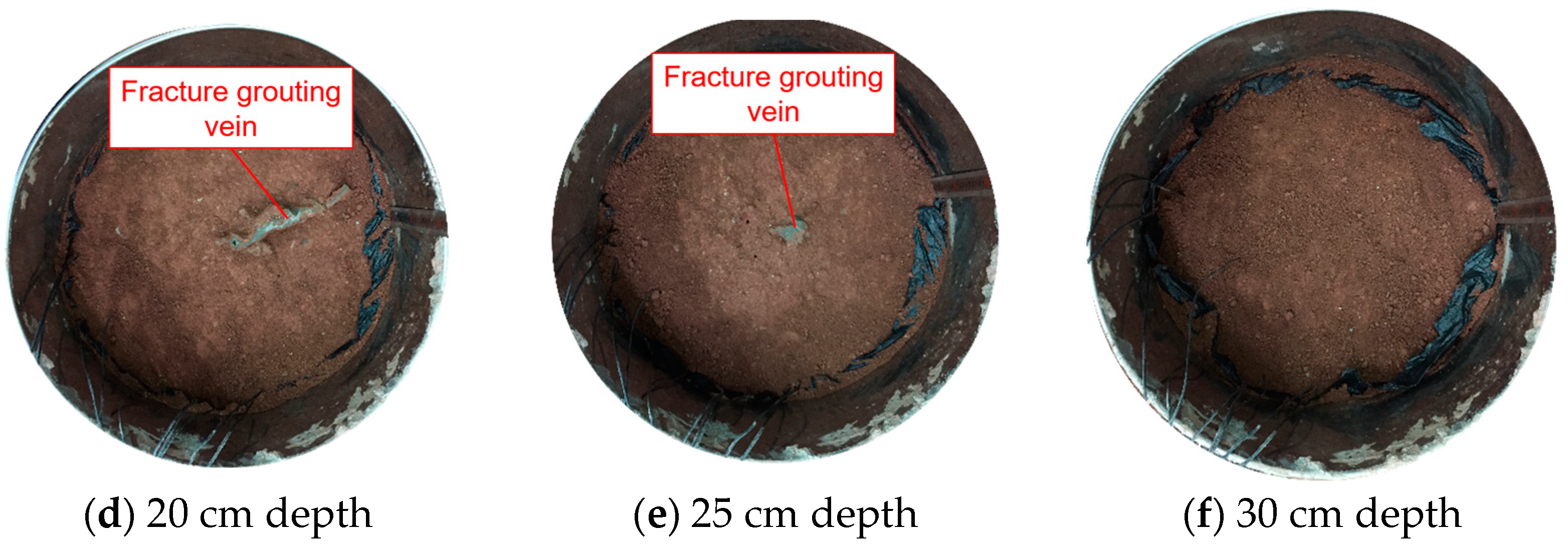
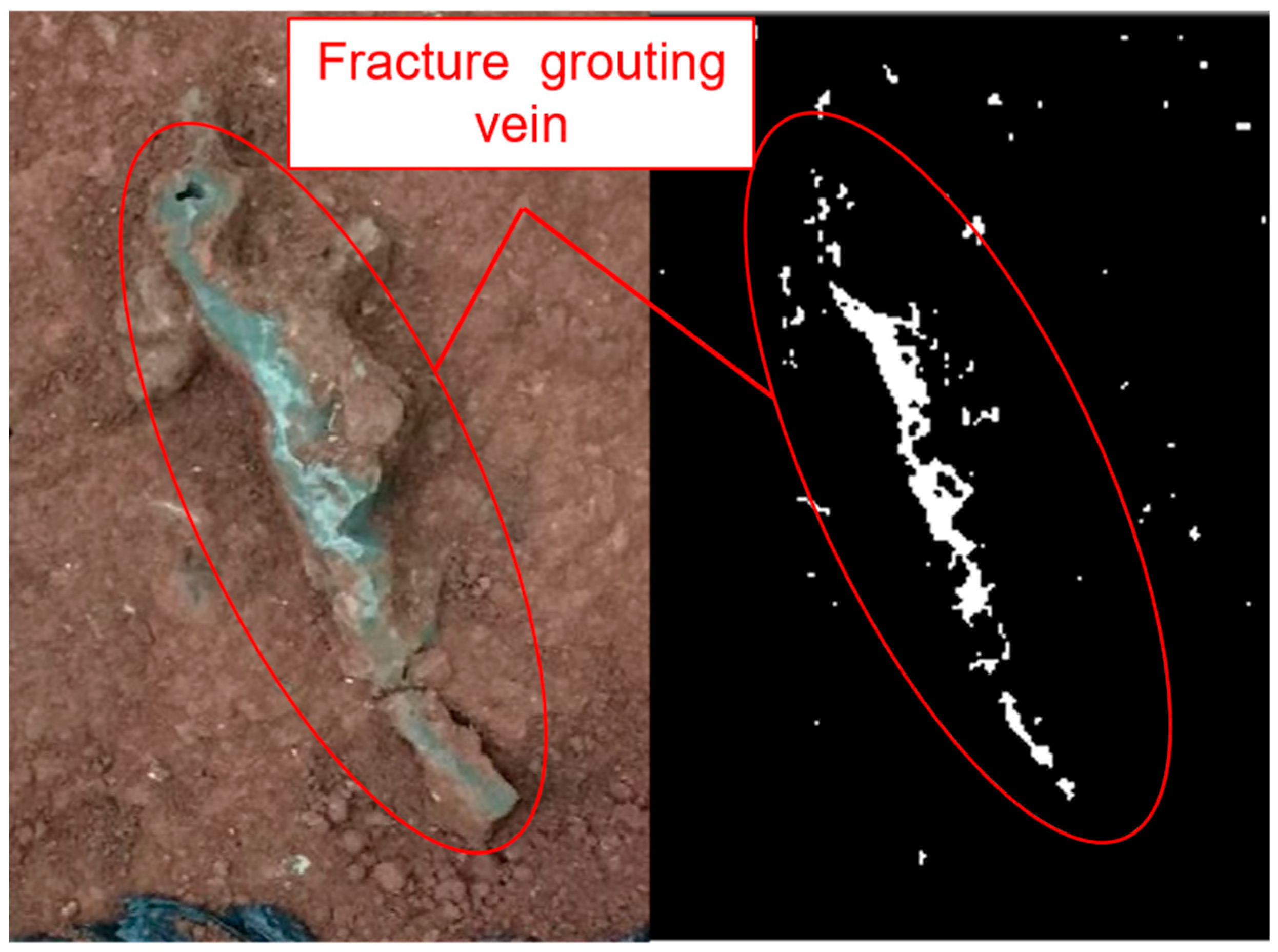
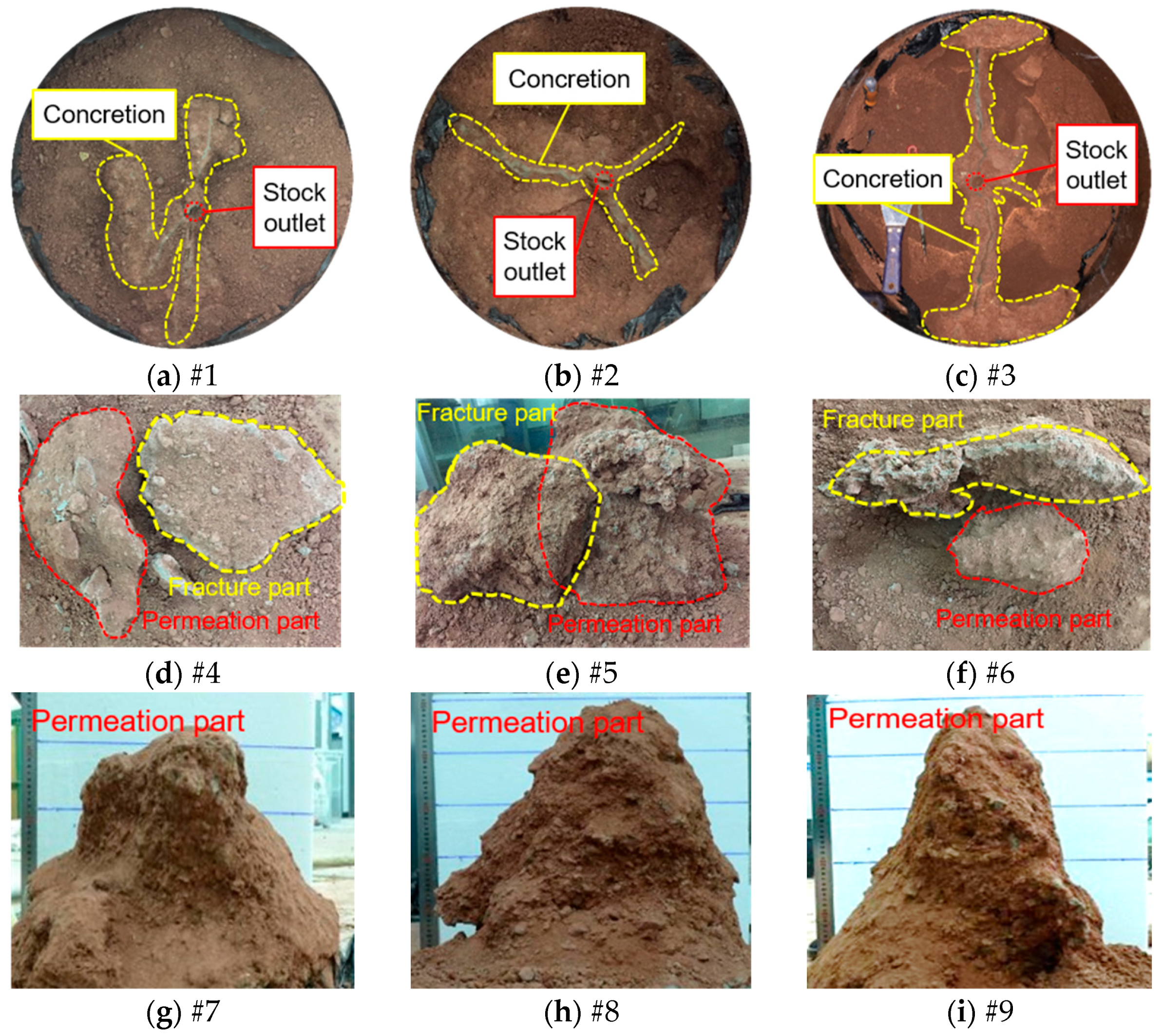


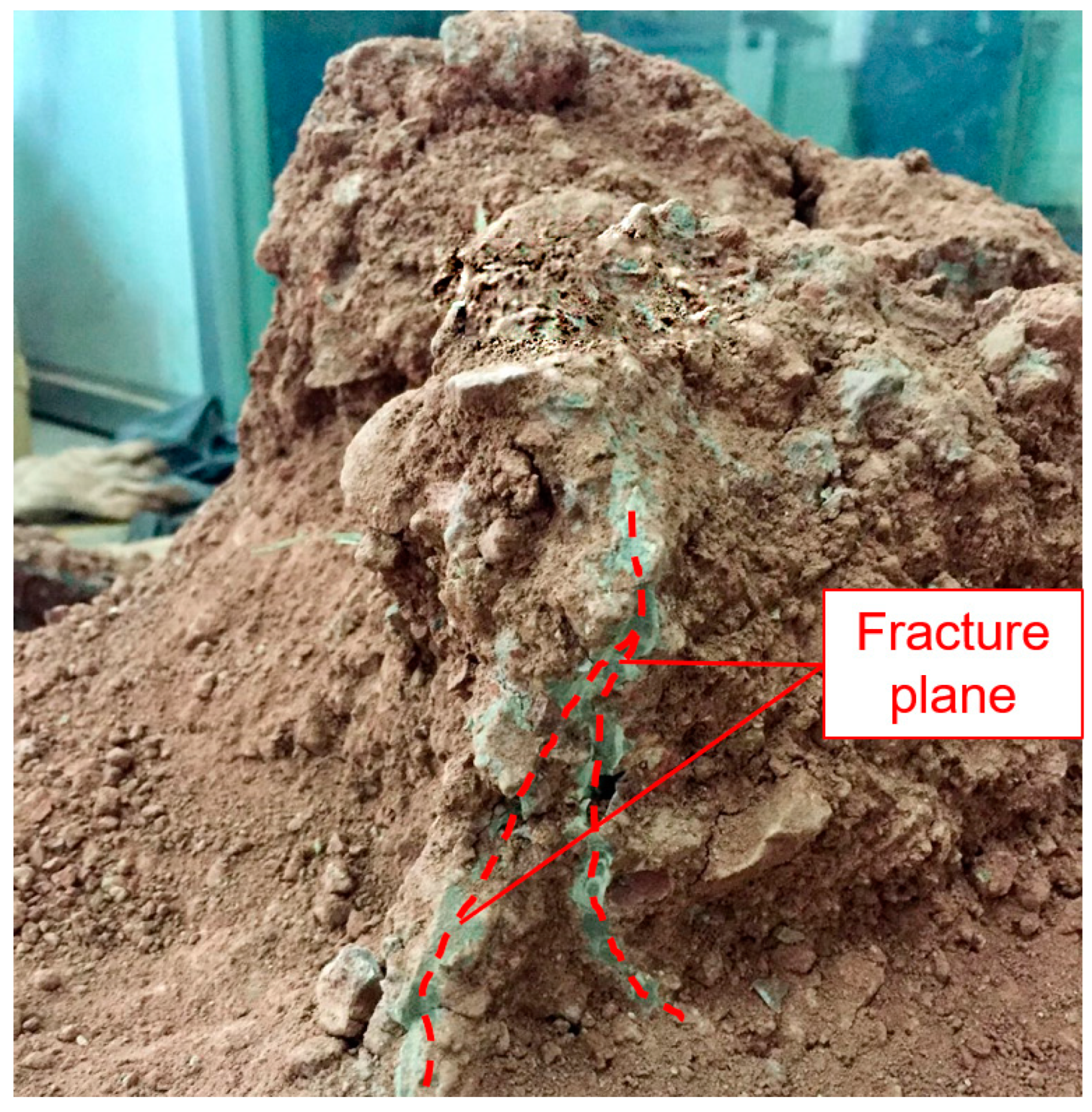


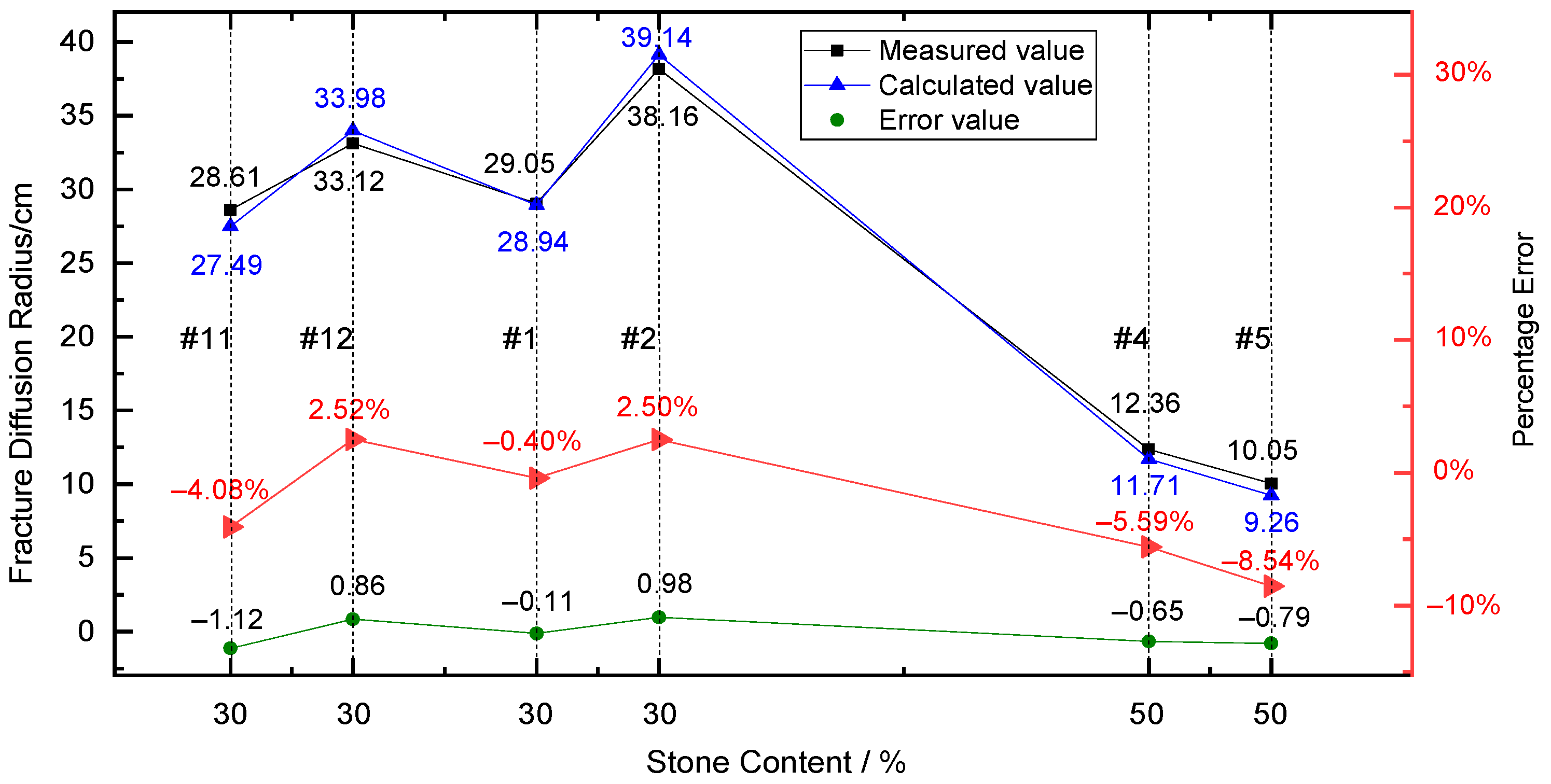
| Groups | Stone Content (%) | Void Ratio | Water-Cement Ratio | Grouting Pressure (MPa) |
|---|---|---|---|---|
| 1 | 30 | 0.3 | 0.6 | 0.4 |
| 2 | 30 | 0.35 | 0.8 | 0.7 |
| 3 | 30 | 0.4 | 1 | 1 |
| 4 | 50 | 0.3 | 0.6 | 1 |
| 5 | 50 | 0.35 | 0.8 | 0.4 |
| 6 | 50 | 0.4 | 1 | 0.7 |
| 7 | 70 | 0.3 | 1 | 0.7 |
| 8 | 70 | 0.35 | 0.6 | 1 |
| 9 | 70 | 0.4 | 0.8 | 0.4 |
| 10 | 0 | 0.3 | 0.6 | 0.4 |
| Groups | Void Ratio e | Nonuniformity Coefficient Cu | Coefficient of Curvature Cc | d20 (mm) | (°) | Shearing Strength | Cohesive Force c (kPa) | Compression Modulus |
|---|---|---|---|---|---|---|---|---|
| 1 | 0.3 | 37.00 | 1.32 | 0.23 | 16.7 | 110 | 23 | 7.17 |
| 2 | 0.35 | 37.00 | 1.32 | 0.23 | 16.7 | 110 | 23 | 7.17 |
| 3 | 0.4 | 37.00 | 1.32 | 0.23 | 16.7 | 110 | 23 | 7.17 |
| 4 | 0.3 | 56.43 | 2.93 | 0.61 | 24 | 148 | 15.3 | 7.35 |
| 5 | 0.35 | 56.43 | 2.93 | 0.61 | 24 | 148 | 15.3 | 7.35 |
| 6 | 0.4 | 56.43 | 2.93 | 0.61 | 24 | 148 | 15.3 | 7.35 |
| 7 | 0.3 | 29.17 | 3.72 | 2.5 | 29.1 | 175 | 12.1 | 8.3 |
| 8 | 0.35 | 29.17 | 3.72 | 2.5 | 29.1 | 175 | 12.1 | 8.3 |
| 9 | 0.4 | 29.17 | 3.72 | 2.5 | 29.1 | 175 | 12.1 | 8.3 |
| 10 | 0.3 | 22.50 | 0.43 | 0.15 | 13 | 107 | 37.4 | 7.12 |
| 11–13 | 0.35 | 56.09 | 3.79 | 1 | 16.7 | 110 | 23 | 7.17 |
| Groups | Stone Content (%) | Void Ratio | Water-Cement Ratio | Grouting Pressure (Mpa) |
|---|---|---|---|---|
| 11 | 30 | 0.35 | 0.6 | 0.5 |
| 12 | 30 | 0.35 | 0.8 | 0.5 |
| 13 | 30 | 0.35 | 1.0 | 0.5 |
| Groups | Stone Content (%) | Permeation Diffusion Radius (cm) | Fracture Diffusion Radius (cm) |
|---|---|---|---|
| 1 | 30 | 3.42 | 29.05 |
| 2 | 30 | 4.85 | 38.16 |
| 3 | 30 | 6.42 | 37.09 |
| 4 | 50 | 13.15 | 12.36 |
| 5 | 50 | 18.36 | 10.05 |
| 6 | 50 | 25.36 | 10.25 |
| 7 | 70 | 28.96 | 5.64 |
| 8 | 70 | 28.64 | 4.42 |
| 9 | 70 | 38.79 | 4.21 |
| 10 | 0 | 0 | 23.05 |
| 11 | 30 | 3.92 | 28.61 |
| 12 | 30 | 4.60 | 33.12 |
| 13 | 30 | 5.53 | 39.87 |
| M | m | |||||||
|---|---|---|---|---|---|---|---|---|
| 0.35 | 118 | 116.8 | 2.492 | 8.3 | 13° | 107 | 1.58 | 2 |
| Slurry Flow Pattern | Forms of Diffusion | Groups |
|---|---|---|
| Newtonian fluid | Permeation diffusion | #6, 7 |
| Newtonian fluid | Fracture diffusion | #3, 6, 13 |
| Bingham fluid | Permeation diffusion | #4, 5, 8, 9 |
| Bingham fluid | Fracture diffusion | #1, 2, 4, 5, 11, 12 |
Disclaimer/Publisher’s Note: The statements, opinions and data contained in all publications are solely those of the individual author(s) and contributor(s) and not of MDPI and/or the editor(s). MDPI and/or the editor(s) disclaim responsibility for any injury to people or property resulting from any ideas, methods, instructions or products referred to in the content. |
© 2023 by the authors. Licensee MDPI, Basel, Switzerland. This article is an open access article distributed under the terms and conditions of the Creative Commons Attribution (CC BY) license (https://creativecommons.org/licenses/by/4.0/).
Share and Cite
Zhong, Z.; Li, J.; Bie, C. Theoretical Approach to Predicting the Diffusion Radius of Fracture Grouting in Soil–Rock Mixtures. Appl. Sci. 2023, 13, 4730. https://doi.org/10.3390/app13084730
Zhong Z, Li J, Bie C. Theoretical Approach to Predicting the Diffusion Radius of Fracture Grouting in Soil–Rock Mixtures. Applied Sciences. 2023; 13(8):4730. https://doi.org/10.3390/app13084730
Chicago/Turabian StyleZhong, Zuliang, Jiayong Li, and Congying Bie. 2023. "Theoretical Approach to Predicting the Diffusion Radius of Fracture Grouting in Soil–Rock Mixtures" Applied Sciences 13, no. 8: 4730. https://doi.org/10.3390/app13084730





